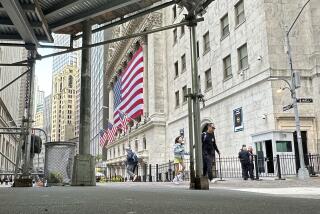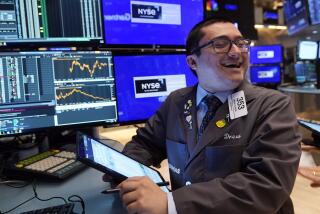Dow Recovers From Plunge; Volume Soars
In one of the most volatile days since the market crashed in 1987, U.S. stocks plunged dramatically Thursday morning but then staged a furious afternoon rally that left the Dow Jones industrial average down only slightly.
After sinking more than 274 points, the Dow finished down 9.78 points at 7,731.91. The Nasdaq composite index, which is packed with big-name technology stocks, dropped43.49 points, or 3%, to 1,419.12. But it rebounded from a 7.2% loss in the morning.
Even with the wide intra-day swings that stock prices seem to regularly make these days, the speed and frenzy of Thursday’s trading stood out. A widely followed index that measures the volatility of the market hit its highest level since the days immediately following the October 1987 stock market collapse.
Volume on the New York Stock Exchange was 1.1 billion shares, the third-heaviest ever.
Investors rushed to sell early after an overnight drop in many foreign stocks and on news that longtime bull Abby Cohen, a strategist at Goldman, Sachs & Co. in New York, had cut her corporate earnings estimates.
Also, trading was riled by more “short covering” by hedge funds that had bet the Japanese yen would weaken further. Instead, the yen soared on Wednesday amid signs that Japan’s banking crisis may ease. That triggering panicked yen buying by hedge funds Thursday, sending the dollar as low as 111 yen early in the day, before closing at 119.05 in New York.
Desperate for cash, some hedge funds sold long-term Treasury bonds, sending the 30-year T-bond yield to 4.99%, up from 4.86% on Thursday--and further depressing stocks for much of the day.
Short-term T-bill yields, meanwhile, plummeted as investors sought safety. The three-month T-bill yield ended at 3.95%, down from 4.13% Wednesday.
But just as technical factors helped drive stocks’ sell-off, they also helped spur the afternoon rally, which then was joined by investors hoping to buy at what they thought could turn out to be the low point in the market.
Indeed, the rebound raised hope that the market pullback that began in mid-July is close to running its course. Many experts said they now expect a short-term rally similar to the one that followed another deep sell-off and recovery on Aug. 31 and Sept. 1.
However, others warned that Thursday did not represent the eagerly awaited “climactic sell-off” in which a final purge would complete the pullback and pave the way for a new rally.
“I wouldn’t be fooled by this late-afternoon rally [into believing] that we’re going back up” immediately, said Byron Wien, senior U.S. equity strategist at Morgan Stanley Dean Witter & Co. in New York.
On the bright side, financial stocks that have been decimated over worries about loans to developing countries and hedge funds rebounded. After falling to yet another new low early in the day, brokerage giant Merrill Lynch recovered strongly and finished the day up $4.75, or 12.6%, to $42.50.
Tech leaders Microsoft and Dell Computer declined, but others such as Lucent Technologies and Cisco Systems showed gains after deep early losses.
In Wall Street parlance, the market had become “oversold,” analysts said. That means stocks had fallen too far too quickly. For example, Cisco had slumped as much as 38% in two weeks.
However, the positives Thursday were offset by a panoply of negatives. On a technical basis, the fact that the Dow held above the 7,400 level--its intra-day low on Sept. 1--was good. But the Standard & Poor’s 500 index briefly dipped below its September trough and finished the day down 1.2%.
The Nasdaq undercut the lows it reached in January and in October 1997, a severely negative sign. What’s more, declining stocks far outnumbered rising issues, by a 27-6 margin on the NYSE and by a 36-8 ratio on Nasdaq.
The Russell 2,000 small-stock index hit a multiyear low, off 3.7% at 310.28.
“You got a lot of buying, but I don’t think it’s serious buying,” said Stan Weinstein, editor of the Professional Tape Reader, a newsletter in Hollywood, Fla.
Fundamentally, some investors were worried by news that Goldman’s Cohen had cut her 1998 and 1999 earnings estimates for the S&P; 500. Cohen cut her 1998 estimate by 3% and 1999 forecast by 4.5%.
Though Cohen reiterated her belief that the S&P; is undervalued by 12% to 15%, and that stocks will reach new highs next year, some Wall Streeters viewed the downgrade as the first step toward toning down her bullish forecasts. Cohen and PaineWebber strategist Edward Kerschner have been Wall Street’s best-known bulls.
Also, Ralph Acampora, technical analyst at Prudential Securities, said the Dow could drop as low as 6,500, compared with the 7,400 bottom he predicted earlier. The revised call followed by a day a forecast by J.P. Morgan Securities that a U.S. recession will occur in 1999.
Still, the market’s latest swings may be as much technical as tied to economic fundamentals, some pros argue. For example, as the market neared its Sept. 1 lows Thursday morning, a plethora of so-called stop-loss orders were triggered, thus furthering the decline. As big institutions had moved into the market cautiously since the Sept. 1 low, they put in these orders requiring their brokers to sell stocks if they fell to certain levels.
Then, as the market rebounded, many traders who had shorted stocks--or made bets that they would fall further--opted to unwind their trades and buy stocks back.
Among Thursday’s highlights:
* Among financial shares, Lehman Bros. surged $4.69 to $29.44 after hitting $22.63. Morgan Stanley Dean Witter climbed $3.19 to $41.63 and Bankers Trust jumped $5.31 to $54.50 after hitting $45.
* U.S. home builders’ shares fell on concern that earnings growth will slow along with a cooling economy. Centex fell $3.25 to $27.44, while Kaufman & Broad dropped $2 to $18.31. Pulte eased $1.13 to $20.13.
* Among the tech leaders, Dell Computer was off $2.13 at $48.44 and Microsoft declined $2.94 to $91.19 after falling as low as $87.75.
Internet shares continued their slide of recent days, with Yahoo down $9.56 to $104.81. The drop in the company’s stock came even though it reported quarterly profit late Wednesday that beat analysts’ forecasts.
* Gibson Greetings plunged $6.38 to $10.88 as the greeting card company warned that it will post a third quarter loss.
Market Roundup, C8
* WHAT’S THE MESSAGE?: Is market foretelling--or spurring--recession? A1
* PRECIOUS ADVICE: Look before you leap into gold funds. C4
(BEGIN TEXT OF INFOBOX / INFOGRAPHIC)
Markets’ Manic Swings
Since Tuesday, the Dow Jones industrial average has shown a net change of just 11 points. Butthe intraday volatility has been astounding, amid sharp swings in currency and bond markets. A look at recent trading in three key indicators:
The Dow Recovers . . .
Dow industrials
Thurs. close: 7,731.91
*
. . . the Dollar Tries To . .
Dollar in Japanese yen
Thurs. close: 119.05 *
. . . As Yields Begin Rising
30-year Treasury bond yield, daily closes
Oct. 8 4.99%
Source: Bloomberg News
More to Read
Inside the business of entertainment
The Wide Shot brings you news, analysis and insights on everything from streaming wars to production — and what it all means for the future.
You may occasionally receive promotional content from the Los Angeles Times.










